Key words
Mastacembelus mastacembelus, otolith size, total length
Introduction
This species generally carries the whole characteristics of the Mastacembelidae with a thin and long body structures. On its prolonged head, there is a dangling trunk like, three leveled salient flesh on the brink of the nose. They have welldeveloped sharp teeth on the jaws. There are 32 to 34 separately located spines between dorsal fin and the head. Three of these spines are also seen in front of the anal fin. They have no ventral fin (Ero?lu and ?en, 2007).
The size and shape of otoliths, which are an important bony structure used for age determination in fishes are variable according to species and size of fish. By using the relationship between fish length and otolith length, it is possible to determine fish length from otolith length or vice versa. This information especially is very useful for analysis of digestive tract content of fishes feeding on the other fishes. Furthermore, it is possible to estimate size and species of eaten fishes from otoliths which are found in digestive tract of the pisivorous fishes (Ayd?n et al., 2004). Granadeiro and Silva (2000) had used otoliths and vertebrae in the identification and sizeestimation of fish in predator-prey studies.
Determining fish age by examining otolith has been reported by many researchers (Lagler, 1956; Chugunova, 1963; Tesch, 1968; Jellyman, 1979; Özdemir and ?en, 1986; Beamish and McFarlane, 1987; Ekingen and Polat, 1987; Çelikkale, 1991; Erkoyuncu, 1995; Polat and I??k, 1995; Geldiay and Bal?k, 1996; Akyol et al., 1997; Metin et al., 1997; Deriso and Quinn, 1999). Fish length-otolith length relationships have also been determined by some researchers (Appelbaum and Hechte, 1978; Akyol et al., 1997; Metin et al., 1997; Harvey et al., 2000; ?en et al., 2001; Morley and Belchier, 2002; Munk and Smikrud, 2002; Strelcheck et al., 2003; Ayd?n et al., 2004; Uçkun et al., 2006; Y?lmaz and Polat, 2008).
The present paper describes the relationship between total lengths and otolith size (length, width and weight) in M. mastacembelus (Banks & Solander, 1794) from Karakaya Dam Lake, Malatya, Turkey. We could not find any paper dealing with the relationship between fish lengths and otolith size of this species in Turkey or any other country for comparison. So, the findings will be very useful for the studies on subjects mentioned above and for the corresponding studies which will be carried on for the other species in Mastacembelidae family.
Material and Methods
Karakaya Dam Lake is the third largest dam lake on the River Euphrates (in respect to the surface area of lake) right after Keban Dam Lake and Karakaya Dam Lake which is situated 166 km downstream Keban Dam, in the locality of Seki Ba?lar?, near the country of Çüngü? of Diyarbak?r province. Other than Euphrates as the main river, Sultansuyu, Tohma Brook, and other small brooks and streams join Karakaya Dam Lake (Anul, 1995).
This study was carried out between February 2002 and January 2003. During this time, 187 specimens of M. mastacembelus (Banks & Solander, 1794) were examined. Fish specimens were caught by gill-nets with mesh-size ranging from 22 to 36 mm. Total lengths of fish samples were measured and then their sexes were determined. Sagittal otoliths were removed, cleaned and fixed in 96% ethyl alcohol according to method given by Chugunova (1963). The lengths and widths of otoliths were measured under binocular microscope marked Olympus CX41 with Olympus DP25 monitoring system. The weights of otoliths were measured with AND-HR-200 (sens ±0.0001g). The results were separated according to sex and statistically tested with t-test and the correlation coefficient of these relations were interpreted according to Fowler and Cohen (1992).
The total length-otolith size relationships were examined by using the following equation: y=bx+a, where, y=otolith size, x=total length, a=intercept value, b=coefficient value.
Results and Discussion
In this study, total 187 specimens belonging to the M. mastacembelus have been examined. Total lengths of them were ranged between 237-806 mm. Sagittal otolith (Figure 1) lengths and widths were ranged between 1.44-3.82 mm and 0.80-1.71 mm, respectively. Otolith weigths were determined between 0.0003-0.0038 g (Table).
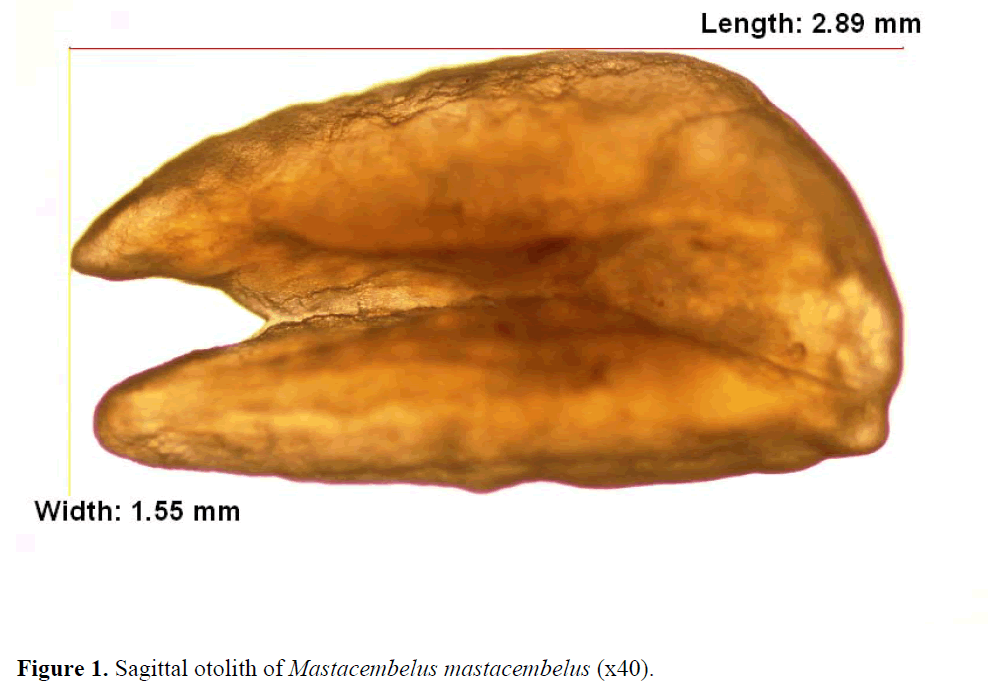
Figure 1. Sagittal otolith of Mastacembelus mastacembelus (x40).
A stronger and positive linear relationship between total length-otolith size (length, width and weight) were found in females, males and all fish (Figure 2-10). However, the effect of sex on otolith size (length, width and weight) of fish was statistically found significant (p<0.001).
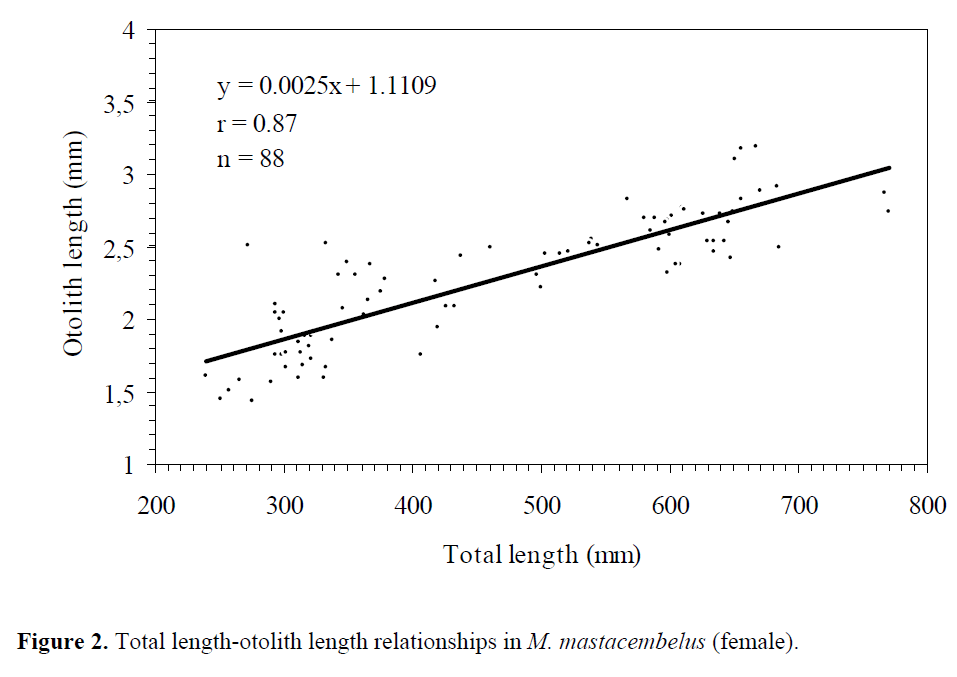
Figure 2. Total length-otolith length relationships in M. mastacembelus (female).
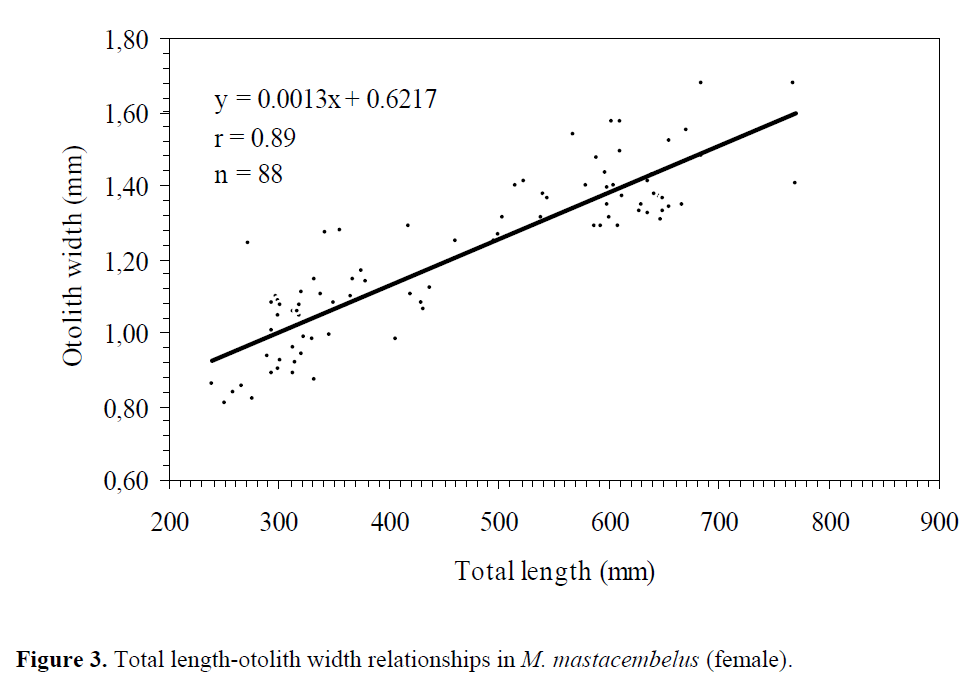
Figure 3. Total length-otolith width relationships in M. mastacembelus (female).
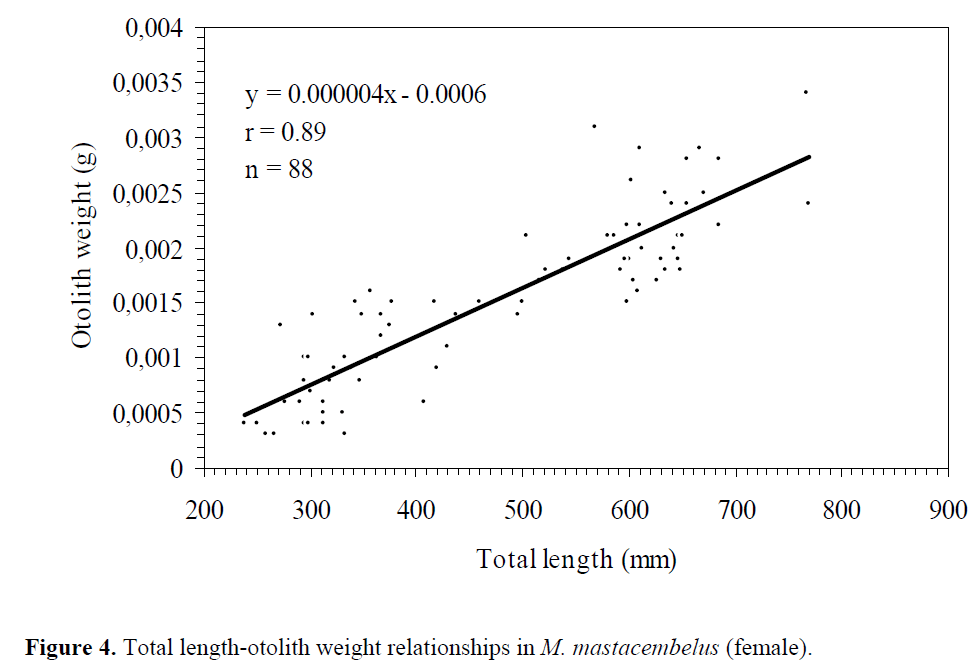
Figure 4. Total length-otolith weight relationships in M. mastacembelus (female).
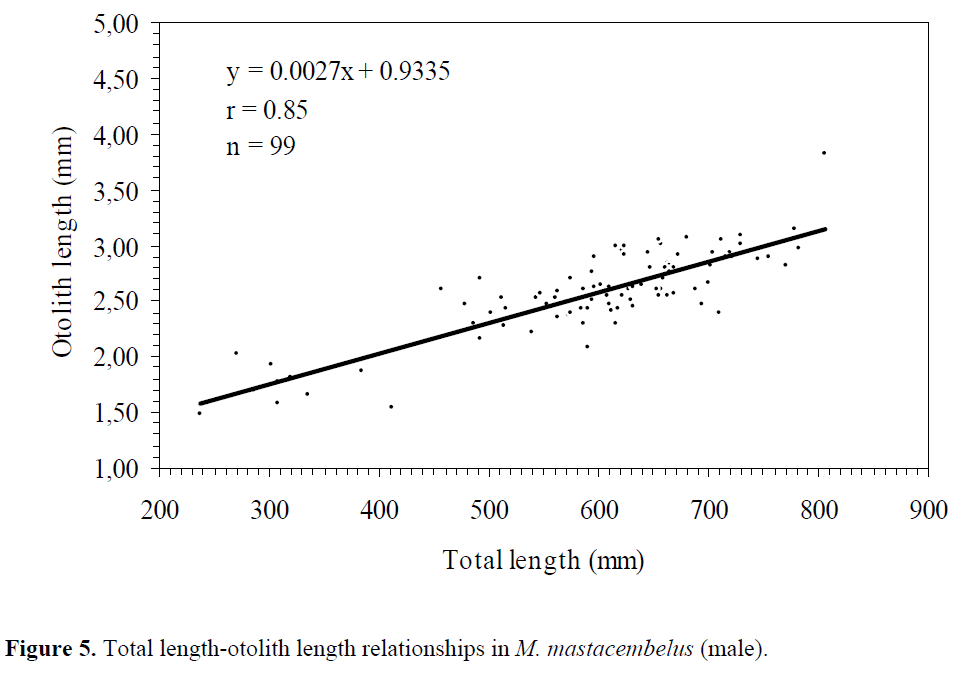
Figure 5. Total length-otolith length relationships in M. mastacembelus (male).
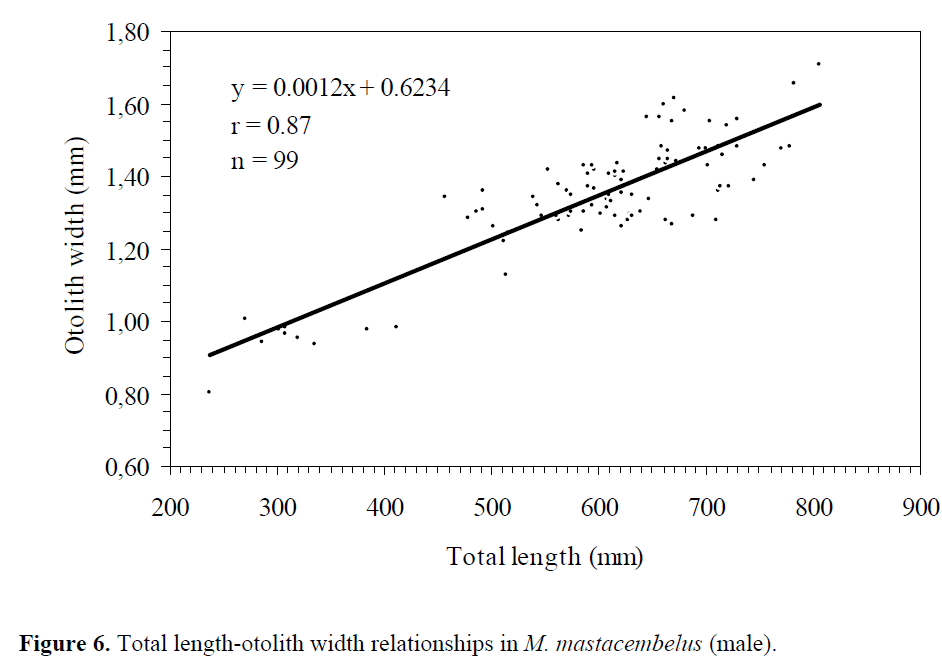
Figure 6. Total length-otolith width relationships in M. mastacembelus (male).
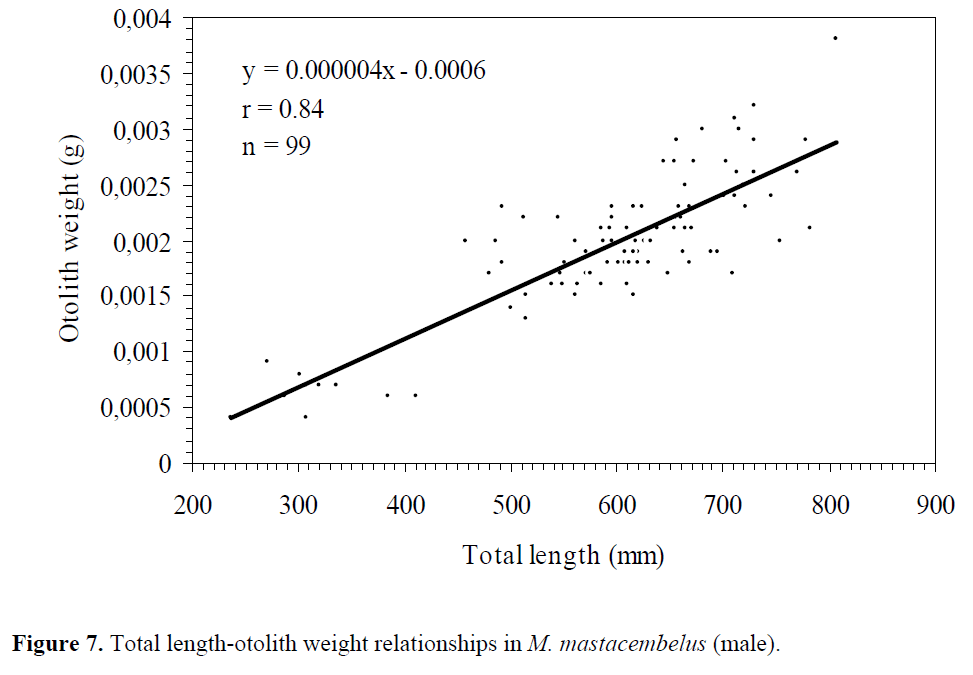
Figure 7. Total length-otolith weight relationships in M. mastacembelus (male).
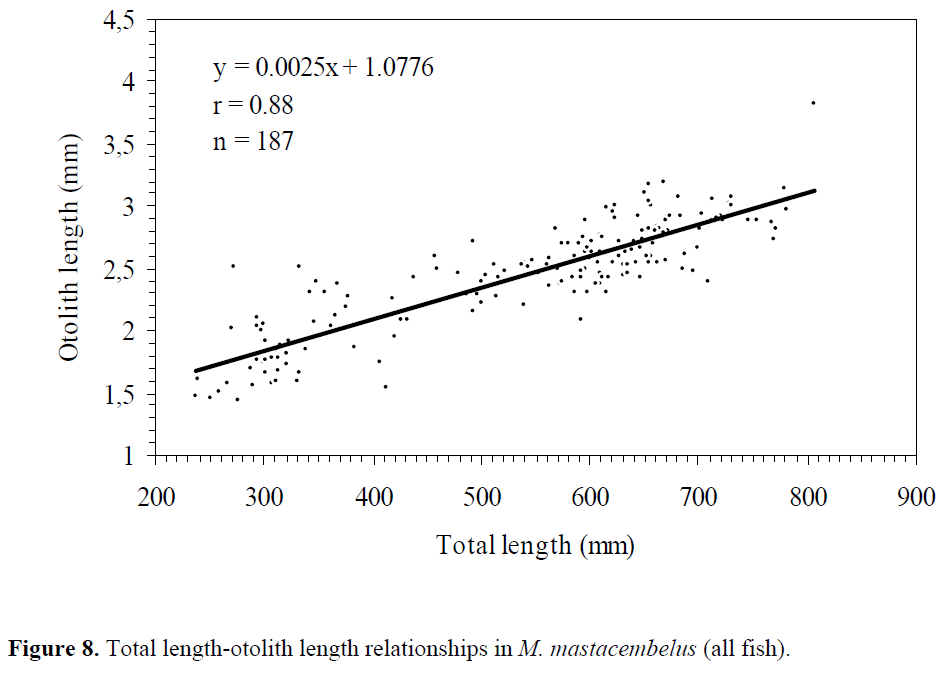
Figure 8. Total length-otolith length relationships in M. mastacembelus (all fish).
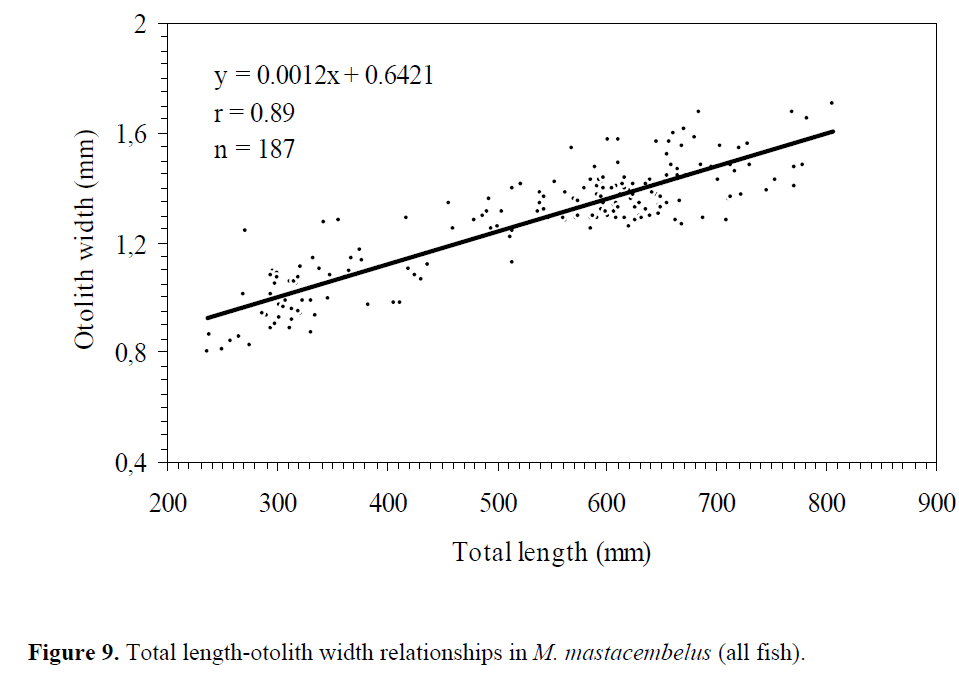
Figure 9. Total length-otolith width relationships in M. mastacembelus (all fish).
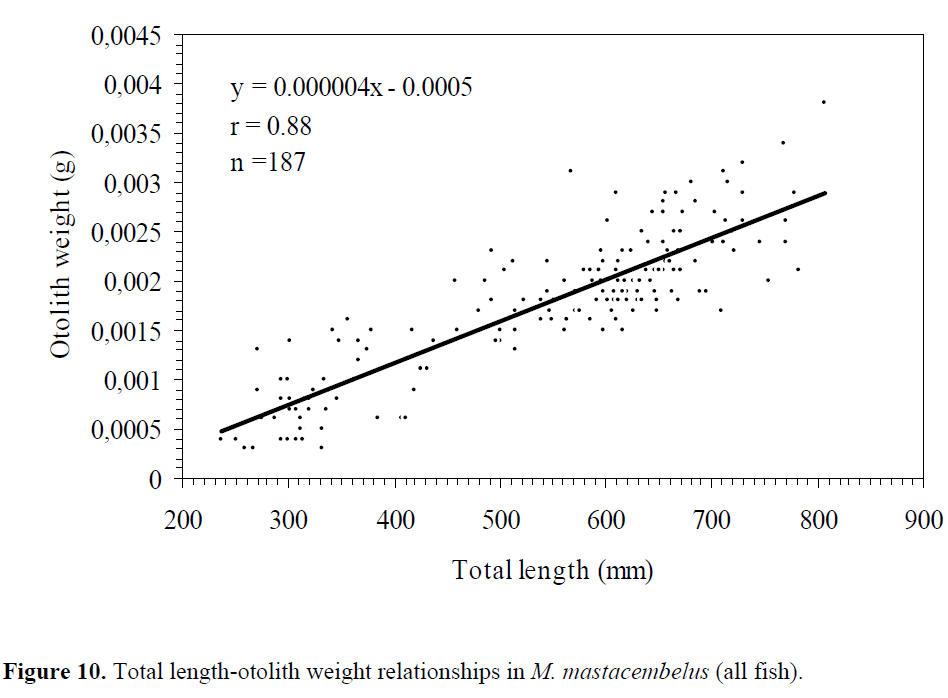
Figure 10. Total length-otolith weight relationships in M. mastacembelus (all fish).
Many researchers (Akyol et al., 1997; Metin et al., 1997; Granadeiro and Silva, 2000; Metin et al., 2001; ?en et al., 2001; Morley and Belchier, 2002; Munk and Smikrud, 2002; Ayd?n et al., 2004; Akal?n et al., 2006; Ceyhan and Akyol, 2006; Samsun and Samsun, 2006; Metin and ?lkyaz, 2008) have found stronger and positive linear relationships between fish length and otolith length in different fish species. However some researchers (Bostanc? and Polat, 2007; Bostanc? et al., 2007; Bostanc? and Polat, 2008; Bostanc? and Polat, 2009) have determined stronger and positive linear relationships between fish length and otolith size (length, width and weight) in different fish species that have different body form.
Conclusion
As a result, it could be pointed out that the fish that have anguilliform body shape as Mastacembelus mastacembelus, a positive and strong correlation between otolith size (length, width and weight) and total length were observed.
Acknowledgment
We would like to present many thanks to Elaz?? Fisheries Research Institute for their supports measuring otolith size.
1150
References
- Akalın, S., Özaydın, O., Uçkun, D., Toğulga, M., (2006). İzmir Körfezi’ndesardalya (SardinapilchardusWalbaum, 1792) larvalarınıngünlükbüyümesiüzerinebirönçalışma, EgeÜniversitesi Su ÜrünleriDergisi, 23(3- 4): 357–360.
- Akyol, O., Metin, G., Unsal S., (1997). Relationship between otolith to fork lengths of sardine (SardinapilchardusWalbaum, 1792) in the bay of İzmir (Aegean Sea), Mediterranean Fisheries Congress, 9-11 April, 925- 929, İzmir.
- Anul, N., (1995). KarakayaBarajGölüLimnolojiRaporu, 53, T. C. BayındırlıkveİskanBakanlığı D. S. İ. G. M. IX. BölgeMüdürlüğü Su ÜrünleriBaşmühendisliği, Keban, Elazığ.
- Appelbaum, S., Hechte, T., (1978). Otolith length/fish length relationship of leptocephali, elvers, and sub-adult (reared) eels Anguilla anguilla, Environmental Biology of Fishes, 3(2): 245-247.
- Aydın, R., Çalta, M., Şen, D., Çoban, M.Z., (2004). Relationships between fish lengths and otolith length in the population of Chondrostomaregium (Heckel, 1843) inhabiting Keban Dam Lake, Pakistan Journal of Biological Sciences, 7(9): 1550-1553.
- Beamish, R.J., McFarlane, G.A., (1987). Current trends in age determination methodology, in Summerfeltet. al., eds, Age and growth of fish, Iowa State University Press 35-42, Ames, Iowa.
- Bostancı, D., Polat, N.,(2007). Dilbalığı, Solealascaris (Risso, 1810)’teotolityapısı, otolitboyutları-balıkboyuilişkileriveyaştayini, FıratÜniviversitesi Fen veMühendislikBilimleriDergisi, 19(3): 265-272.
- Bostancı, D., Polat, N., (2008). BenekliPisi, Lepidorhombusboscii (Risso, 1810)’ninotolityapısı, otolitboyutları-balıkboyuilişkileriveyaştayini, Journal of FisheriesScience. com, 2(3): 375-381, DOI: 10.3153/jfscom.mug.200726
- Bostancı, D., Polat, N., (2009). Yaşıbilinenbalıklarınkemiksiyapılarındagerçekyaşıgöstermeyenhalkaörneği, Journal of FisheriesScience. com, (baskıda), DOI: 10.3153/jfscom.2009015.
- Bostancı, D., Yılmaz, S., Polat, N., (2007). GölhisarGölü (Burdur)’ndekikızılkanat (Scardiniuserythrophthalmus Linnaeus, 1758) populasyonundayaşbelirleme, boy-ağırlıkilişkisivekondüsyonfaktörüüzerinebiraraştırma, Ulusal Su Günleri, 16-18 Mayıs, 99-107, Antalya.
- Ceyhan, T., Akyol, O., (2006). Marmara Denizilüfer (Pomatomussaltatrix L., 1766) balıklarınınyaşdağılımıveçatal boy-otolitboyuarasındakiilişki, EgeÜniversitesi Su ÜrünleriDergisi, 23(1/3): 369-372.
- Chugunova, N.I., (1963). Age and growth studies in fish, 132, Israel Program Scientific Translation, No. 610 National Science Foundation, Washington D.C. USA.
- Çelikkale, M.S., (1991). Balıkbiyoloji, 387, KTÜ SürmeneDenizBilimleriveTeknolojisiYüksekokulu, Trabzon.
- Ekingen, G., Polat, N., (1987). Age determination and length-weight relations of Capoetacapoetaumbla (Heckel, 1843) in Lake Keban, Doga Turkish Journal of Zoology, 11(1): 5- 15.
- Erkoyuncu, İ., (1995). Balıkçılıkbiyolojisivepopulasyondinamiği, 265, OndokuzMayısÜniversitesiYayınları, Sinop.
- Eroğlu, M., Şen, D., (2007). Reproduction biology of Mastacembelussimack (Walbaum, 1792) inhabiting Karakaya Dam Lake (Malatya, Turkey), International Journal of Natural and Engineering Sciences, 1(2): 69- 73.
- Fowler, J., Cohen, L., (1992). Practical statistics for field biology, 227, John Wiley and Sons. Chichester, New York, Brisbane, Toronto, Singapore.
- Geldiay, R., Balık, S., (1996). Türkiyetatlısubalıkları, 532, EgeÜniversitesiBasımevi, Bornova-İzmir.
- Granadeiro, J.P., Silva, M.A., (2000). The use of otoliths and vertebrae in the identification and size-estimation of fish in predator-prey studies, Cybium, 24(4): 383-393.
- Harvey, J.T., Loughlin, T.R., Perez, M.A., Oxman, D.S., (2000). Relationship between fish size and otolith length for 63 species of fishes from the eastern North Pacific Ocean, NOAA Technical Report NMFS 150, U.S. Department of Commerce, Seattle, Washington.
- Jellyman, D.J., (1979). Scale development and age determination in New Zealand freshwater eels (Anguilla spp.), New Zealand Journal of Marine and Freshwater Research, 13(1): 23-30.
- Lagler, K.F., (1956). Freshwater fishery biology, 421, W.M.C. Brown Company, Dubuque, Iowa, USA.
- Metin, G., Akyol, O., Hoşsucu, M., (1997). Otolith and age determination from otoliths of the bony fishes. Mediterranean Fisheries Congress, 9-11 April, 895-901, İzmir.
- Metin, G., İlkyaz, A.T., (2008). Use of otolith length and weight in age determination of Poor Cod ( Trisopterusminutus Linn., 1758). Turkish Journal of Zoology, 32 (3): 293-297.
- Metin, G., Süzer, C., Kınacıgil, H.T., İlkyaz, A.T., (2001). Çipura (Sparusaurata L.) larvalarındaotolitleringünlükgelişimi, EgeÜniversitesi Su ÜrünleriDergisi, 18(3-4): 375–381.
- Morley, S., Belchier, M., (2002). Otolith and body size relationships in bigeye grenadier (Macrourusholotrachys) in CCAMLR subarea 48.3, CCAMLR Science, 9: 133-143.
- Munk, M.K., Smikrud, M.K., (2002). Relationships of otolith size to fish size and otolith ages for YelloweyeSebastesruberrimus and Quillback S. maliger Rockfishes, Regional Information Report No. 5J02-05, Alaska Department of Fish and Game, Juneau, Alaska.
- Özdemir, N., Şen, D., (1986). Age determination by scale, vertebra and operculum of Leuciscuscephalusorientalis (Nordmann, 1840) in the Euphrates, The Journal of Fırat University, 1(1): 101-111.
- Quinn II, T.J., Deriso, R.B., (1999). Quantitative fish dynamics, 542, Oxford University Press, New York, USA.
- Polat, N., Işık, K., (1995). Aging methods and growth rates of siraz fish (CapoetacapoetaGuldenstaedt, 1773) in Altınkaya Dam Lake, Doga Turkish Journal of Zoology, 19(3): 265-271.
- Samsun, N., Samsun, S., (2006). Kalkan (Scophthalmusmaeoticus Pallas, 1811) balığınınotolityapısı, yaşvebalıkuzunluğu-otolituzunluğuilişkilerininbelirlenmesi, FıratÜniversitesi Fen veMühendislikBilimleriDergisi, 18(2): 181- 187.
- Strelcheck, A.J., Fitzhugh, G.R., Coleman, F.C., Koenig, C.C., (2003). Otolith-fish size relationship in juvenile gag (Mycteropercamicrolepis) of the eastern Gulf of Mexico: a comparison of growth rates between laboratory and field populations, Fisheries Research, 60(2): 255-265.
- Şen, D., Aydın, R., Çalta, M., (2001). Relationships between fish length and otolith length in the population of Capoetacapoetaumbla (Heckel, 1843) inhabiting Hazar Lake, Elazığ, Turkey. Archives of Polish Fisheries, 9(2): 267-272.
- Tesch, F.W., (1968). Age and growth. in Ricker eds, Methods for assessment of fish production in fresh waters, Blackwell Scientific Publications, 93-123, Oxford and Edinburg.
- Uçkun, D., Taşkavak, E., Toğulga, M., (2006). A Preliminary study on otolith-total length relationship of the Common Hake (Merlucciusmerluccius L., 1758) in İzmir Bay, Aegean Sea, Pakistan Journal of Biological Sciences, 9(9): 1720-1725.
- Yılmaz, S., Polat, N., (2008). Cyprinuscarpio L., 1758 (Sazan)’nun yaştayiniiçinfarklıkemiksiyapılarındeğerlendirilmesi, SüleymanDemirelÜniversitesi Fen EdebiyatFakültesi Fen Dergisi (e-dergi), 3(2): 149-161.
















